August 17th, 2022 by Carolyn Foley
In this abbreviated interview, Research Coordinator Carolyn Foley and Communication Associate Sarah Gediman ask doctoral candidate Katey Strailey about her Illinois-Indiana Sea Grant-funded work. A researcher in the River and Landscape Systems Research Group at University of Illinois, Strailey is looking at how restoration structures in streams change turbulence, or flow of water, and what effects those changes have on fish.
When restoring streams, people may add physical structures as habitat to help fish, but relatively little is know about which structures are most beneficial. Doctoral candidate Katey Strailey is exploring this question using fish physiology, some really cool technology, and impressive surgical skills.
Q: Why did you choose to pursue this research?
A: Freshwater fish are some of the most endangered vertebrates on the planet. 40-50% of freshwater fish are endangered, and river fish have it particularly bad. Rivers are some of the most altered ecosystem types on the planet, which can cause fish to die or leave.
For centuries, humans have used rivers for hydropower, irrigation, drinking water, and transportation. While we (humans) do a lot of things that make it difficult for organisms to live there, we also try to restore the systems.
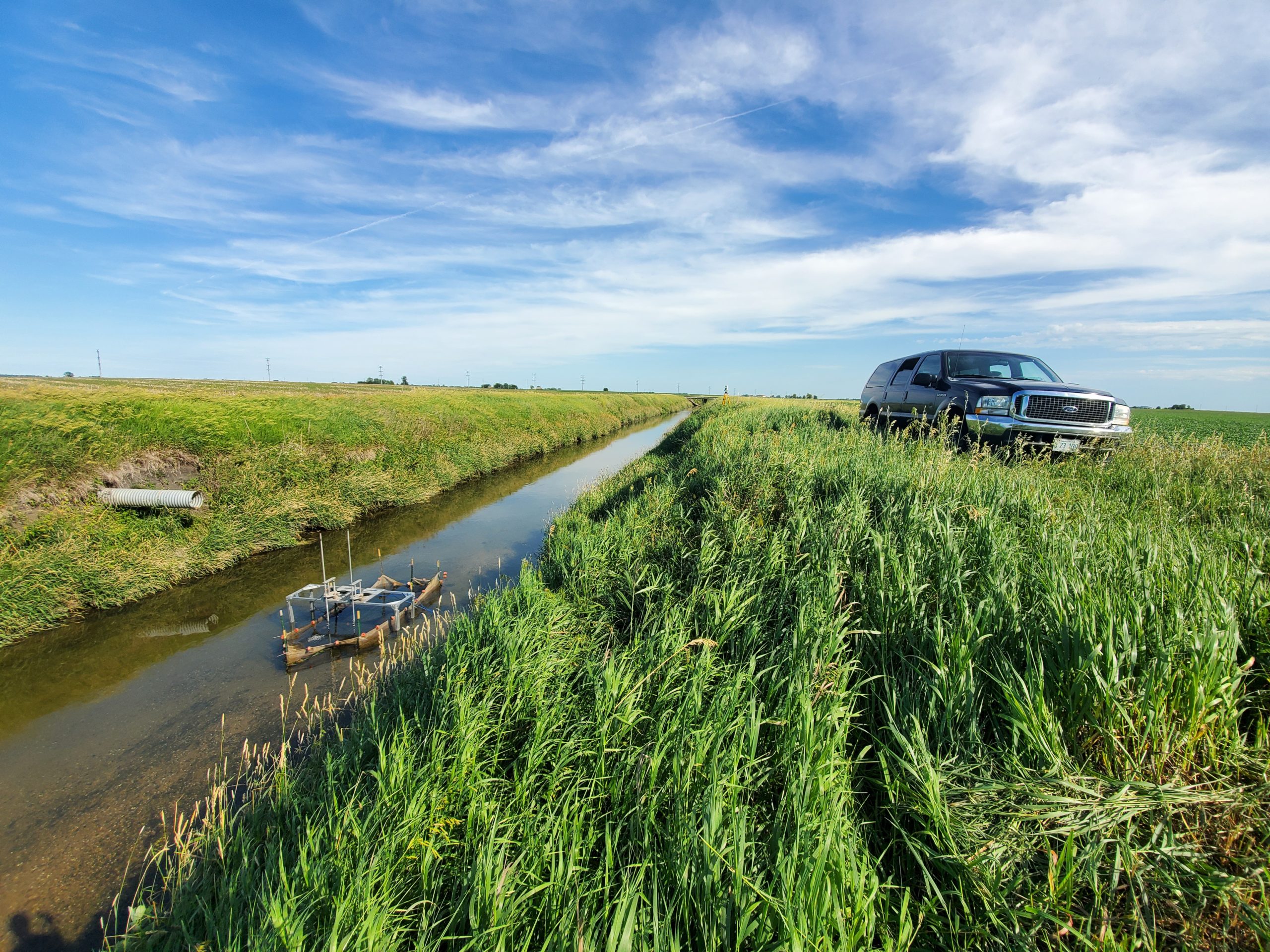
A stream where equipment to measure flow and turbulence has been installed. (Photo courtesy of Katey Strailey)
Q: How can restoration help?
A: Although we can’t always reverse all the damage, we hope that restoration can improve in-stream habitat, increase water quality, and prevent excessive erosion of stream banks. But the jury is still out on how effective current restoration strategies actually are in terms of ecological outcomes. In the U.S. alone, it’s estimated that more than $1 billion is spent on river restoration every year, and so we wanted to explore the how it’s helping question a bit more.
Q: For those of us who don’t know much about stream restoration, what new information will your research contribute to the discipline?
Our research focuses on understanding what makes certain turbulence beneficial or harmful for fish. Turbulence is the swirling, chaotic flow you see when you look at a river. That chaos can make it harder for fish to swim, but some types of turbulence actually help fish. Different structures, as the flowing water moves around them, cause different kinds of turbulence. Since structures are often placed in rivers or streams with a goal of helping fish, we need to be sure that fish actually want to be by them, and that they’re not driven away by them.
One issue with this type of research is that, between limited funding and short funding timelines, it’s really common for people to do a project, monitor it for a year or two, and then move on. But we know that it can take 10-15 years to see the effects a single project has on fish populations. This is where studying fish physiology has an advantage—we can use short-term experiments to understand how restoration actions directly affect individual fish. When you can measure a fish’s oxygen consumption before and after placing an object in the water, and immediately calculate the difference, it’s easier to establish that causal link. It can also hint at how fish might be affected over the long term. So, with the information we generate, we want to develop a tool that can help scientists and practitioners create restoration plans that will most benefit the fish in streams that are being restored.
Q: What types of structures do you use to test fish?
Structures in a stream, whether they be natural or designed and placed by people, are often fairly complex. But for the purposes of our experiments, we break them down to basic components. An example is what we refer to as “large woody debris”, which can be logs, branches, and root wads tangled up together. To test how they might affect fish, we can break them down to the characteristics of their components: how big might a branch be? What is its diameter? How is it oriented in the flow?
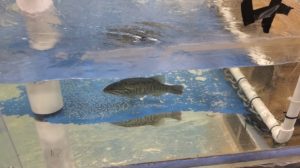
A smallmouth bass is held in a tank during experiments to understand how turbulence around structures affects fish. (Photo courtesy of Katey Strailey)
In my work, I place cylinders that vary by diameter and orientation into tanks to explore how the basic components of structures change the flow. This allows me to very finely link fish responses and flow characteristics to the cylinder and orientation I’m using. For example, lunkers are popular hiding spots for many fish; they look like small wooden caves in the riverbank. Because the overhead components do not affect the flow, we can simulate these structures in our lab experiments using vertical cylinders, then assess their unique turbulence. We can also assess structures found in other natural habitats, such as riffles, that are often incorporated into restoration projects.
Q: What are the mechanics of your experiment?
I honestly think I get to do really cool stuff! Essentially what we’re doing is measuring the decline of oxygen in water as fish do their thing (swim). How much oxygen a fish uses as it swims is linked with how much energy it’s using. By measuring the oxygen they use, we also know how hard they’re working and how much energy they’re using to swim. The catch with oxygen consumption is that with fish, it has to be measured in a completely closed environment with a limited amount of water. If you have too much water, open to the environment, you can’t really know how much of that oxygen is being used by the fish specifically. I use what’s essentially a fish treadmill to measure the oxygen they use: it looks like a little racetrack, the fish hangs out in one section of this racetrack, and the flow recirculates so they can keep swimming while staying in place.
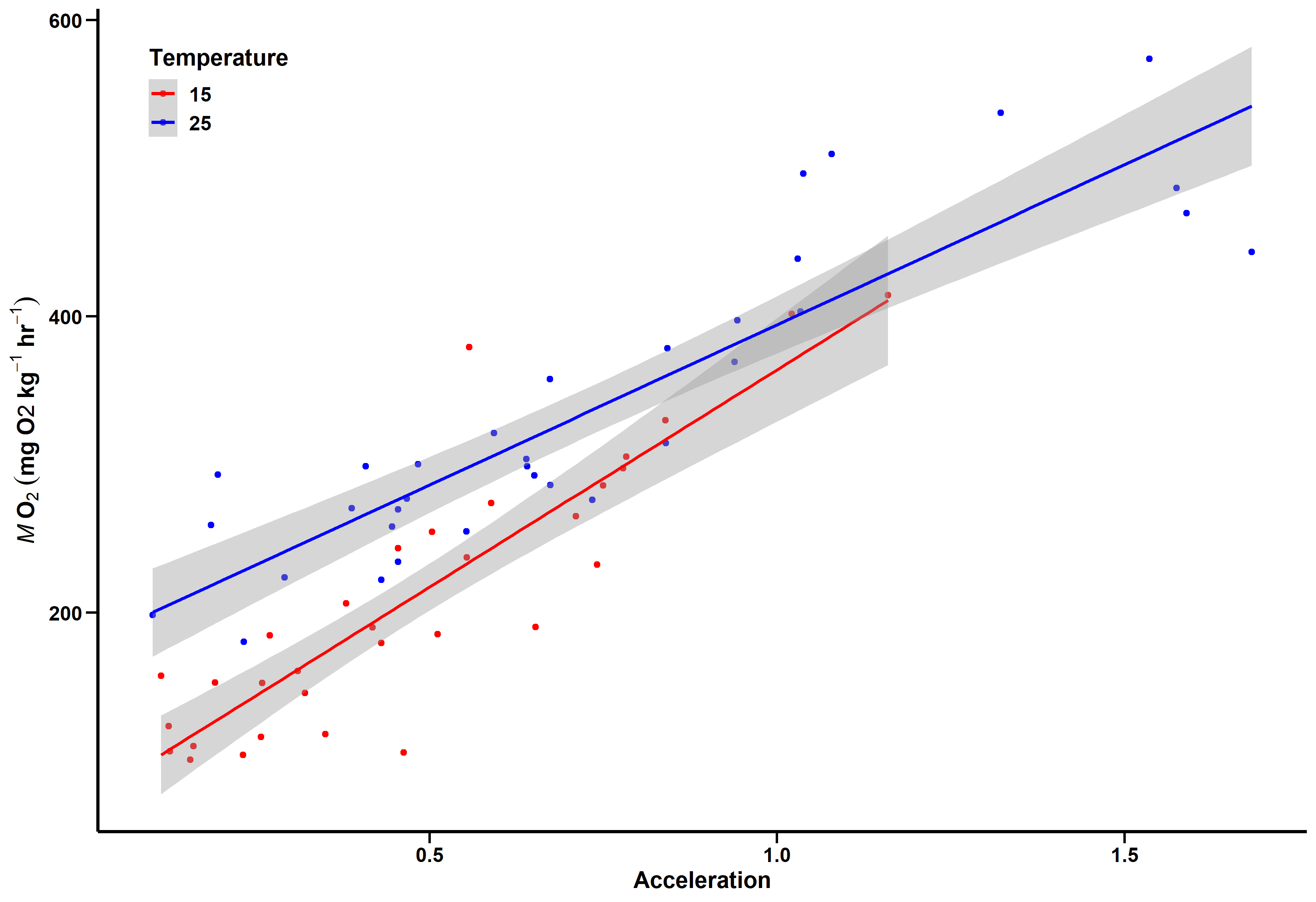
Katey Strailey uses graphs like this to understand how a fish’s oxygen use and their acceleration are related. (Graphic courtesy of Katey Strailey)
Since I can only directly measure this in the fish treadmill, if I want to test them in other environments I have to use a proxy. For my research, that proxy is acceleration. While they’re swimming in the treadmill and I’m measuring the oxygen use, I also measure their acceleration using an accelerometer. This same type of technology is used in smartphones to tell if you’re holding the phone upright or on its side.
Q: How exactly do you use an accelerometer with the fish?
A: I do fish surgeries! I just take these tiny accelerometers and slip them into the fish and let them recover. My fish are very resilient and recover quickly – within minutes, they’re back swimming with their fish buddies. I’ve done well over 100 surgeries and I’ve never lost a fish, ever. When the accelerometer is in a fish and can communicate with a receiver I have, I can put the fish in any kind of environment and then estimate how much energy they’re using to swim, thanks to the link to the fish treadmill that we already talked about.

A rainbow trout is held in a tank while oxygen and acceleration are measured. (Photo courtesy of Katey Strailey)
Q: What gets you most excited about this project?
A: We aren’t just sticking with the lab! We are moving towards real world and real river environments. Other studies have looked at the interactions between fish and turbulence, but it oftentimes comes from an interesting novelty angle. There’s not much research that applies this to a conservation or restoration context. Our ultimate goal here is to find new tools, or something that can complement other methods, to help refine best practices during restoration efforts.
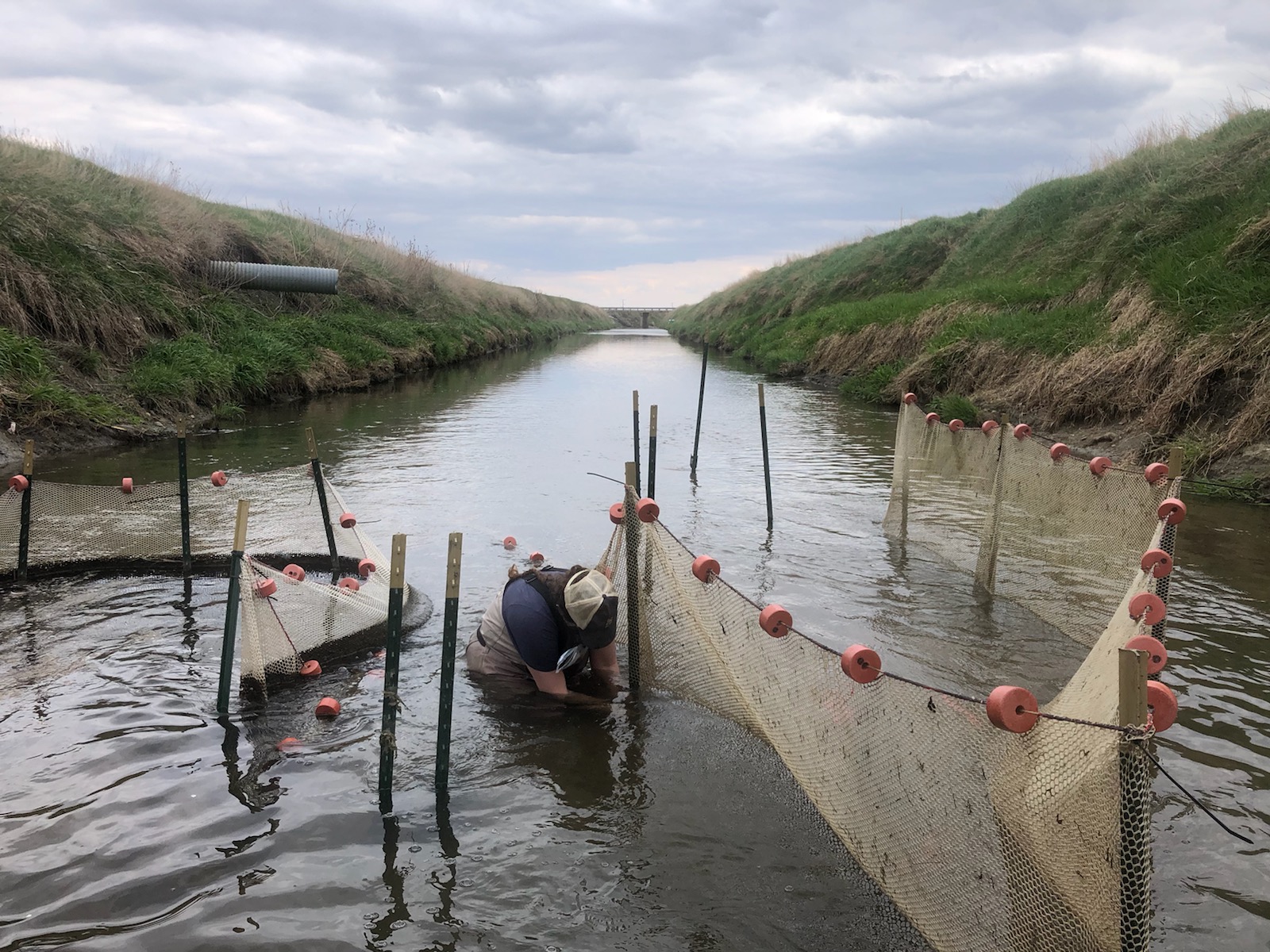
Researchers repair field enclosures. These help understand effects of river and stream restoration on fish. (Photo courtesy of Katey Strailey)
Q: What species do you use?
A: I’ve used two species: rainbow trout and smallmouth bass. The rainbow trout are the ideal species for any study looking at fish and turbulence because of their body shape, which is sort of narrow like salmon and other fish that are raised in hatcheries and then released into streams that feed Lake Michigan.
Another thing I am excited about is that when I was doing my large-scale lab experiments, a lot of my fish would go behind an object oriented vertically in the water. The fish position their bodies so that when a vortex of turbulence comes towards them, their body takes advantage of it and propels them forward into the turbulence. Some fish have this great body shape that can swim upstream without exerting energy. It looked like the smallmouth bass may have done that, but I need to do more trials.
Strailey’s research is a highly collaborative effort across the University of Illinois that includes Cory Suski from Natural Resources and Environmental Sciences, Piotr Cienciala and Bruce Rhoads from Geography and Geographic Information Systems, and Rafael Tinoco from Civil and Environmental Engineering. You can learn more about the exciting research that Katey is conducting by following @_FishFizz, @Piotr_Cienciala, and @rafaelotinoco on Twitter, or by exploring this entry in the IISG Research Project Database: https://iiseagrant.org/research-project/investigating-fish-energy-use-and-swimming-behavior-in-turbulent-flows-guiding-restoration-of-lake-michigan-tributaries/. This abbreviated transcript was edited for length and clarity.
Illinois-Indiana Sea Grant is a part of University of Illinois Extension and Purdue Extension.
Contacts:
Katey Strailey, ks26@illinois.edu
Carolyn Foley
February 5th, 2018 by IISG
WEST LAFAYETTE, Ind. – Purdue University will administer the Illinois-Indiana Sea Grant College Program (IISG), previously managed by the University of Illinois, effective Feb. 1, 2018. New IISG director Tomas Höök, a fisheries biologist in Purdue’s Department of Forestry and Natural Resources, will lead the administration.
IISG research, outreach and education efforts bring the latest science to southern Lake Michigan residents and decision makers and empower them to secure a healthy environment and economy.
The program has been a leader in the region on aquatic invasive species control, pollution prevention and Great Lakes literacy, and has developed decision tools that help communities grow while protecting natural resources. Illinois-Indiana Sea Grant supports more than 50 permanent medicine collection programs in the Great Lakes region, has helped the Indiana aquaculture industry grow fivefold and provides resources for municipalities to plan for future water supplies.
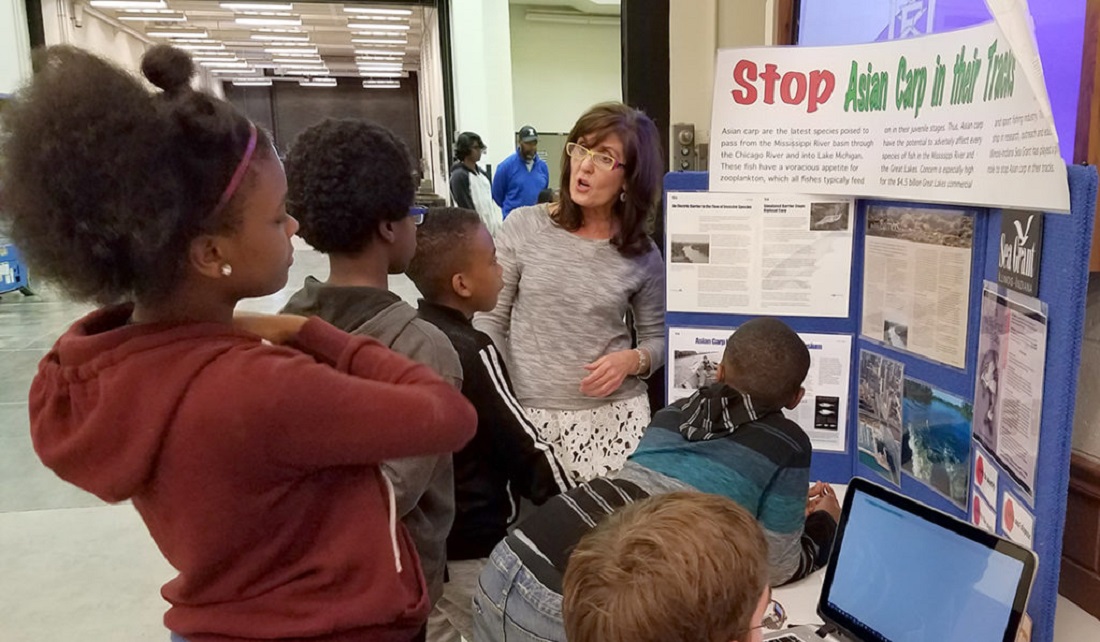
Terri Hallesy, IISG education coordinator, engages elementary students at the University of Illinois’ Brady STEM Academy about the threat of Asian carp to the Great Lakes.
IISG is funded through the National Oceanic and Atmospheric Administration (NOAA), Purdue University and the University of Illinois.

Tomas Höök, Director
“While Illinois-Indiana Sea Grant has recently been administered by the University of Illinois, it has always been a truly bi-state program,” says Höök, who has served as IISG’s associate director for research since 2010. “For the past 16 years, the program has greatly benefitted from IISG leadership at Illinois, especially Brian Miller and Lisa Merrifield. With program administration moving to Purdue, IISG will continue to work to empower Lake Michigan communities in both Illinois and Indiana through applied discovery and information dissemination.”
Purdue University and the University of Illinois have worked closely to oversee IISG since 1982, periodically transferring the program directorship. Over its 36 years, the program has maintained an administrative presence at both universities.
“When I started my career with Sea Grant in 1994, we were going through an administrative transition similar to the one happening right now,” says Brian Miller, who has been program director for 11 years and is now retiring. “What we have accomplished since that time provides a wonderful platform for even greater growth in the future.”
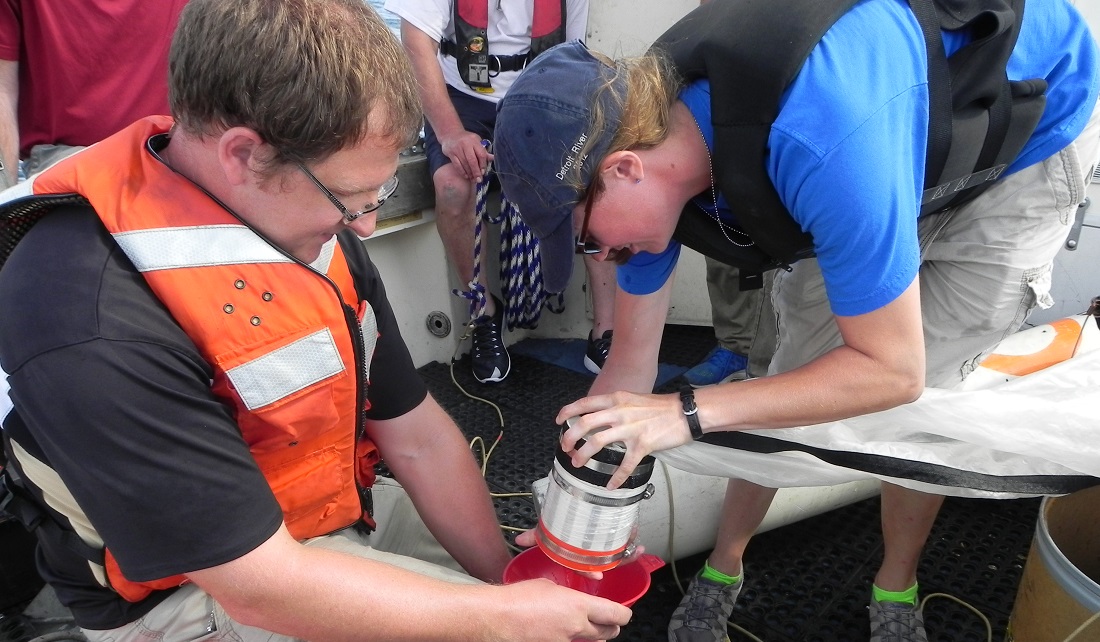
IISG Aquatic Ecologist Jay Beugly helps Purdue University student Margaret Hutton sample Lake Michigan water near Wilmette, Illinois.
IISG is part of the National Sea Grant College program, established in 1966 to protect and preserve America’s coastline and water resources to create a sustainable economy and environment. The network consists of a partnership between NOAA and 33 university-based programs in every coastal and Great Lakes state.
April 5th, 2016 by IISG
University of Illinois PhD students Pongsakorn “Tum” Suppakittpaisarn, pictured above on the right, and Fatemeh Saeidi-Rizi, pictured above on the left, study rain gardens—but not in the way you’d expect. Instead of measuring infiltration rates and pollution reduction capacity, Tum and Fatemeh want to know what happens in our brains and bodies when we see this green infrastructure practice.
A growing number of studies draw connections between access to green spaces and our physical and mental health. But, Tum said, most of that work has revolved around larger, more ubiquitous landscapes like public parks and tree-lined streets.
“We know green spaces generally are good for mental health,” he said. “But the ‘how’ and ‘why’ is still unclear, especially with rarer landscape types like rain gardens.”
So Tum and Fatemeh, along with collaborators at the University of Illinois’ Sustainability and Human Health Lab and the Health People-Health Landscape Lab at National Taiwan University, are working together to measure physical responses and changes in brain activity triggered by images of rain gardens.
The team has compiled 216 rain garden photos taken across the U.S. into nine different videos. In Illinois, Tum will use biofeedback sensors to measure what happens to participant heart rates, body temperatures, and more when they see these videos.
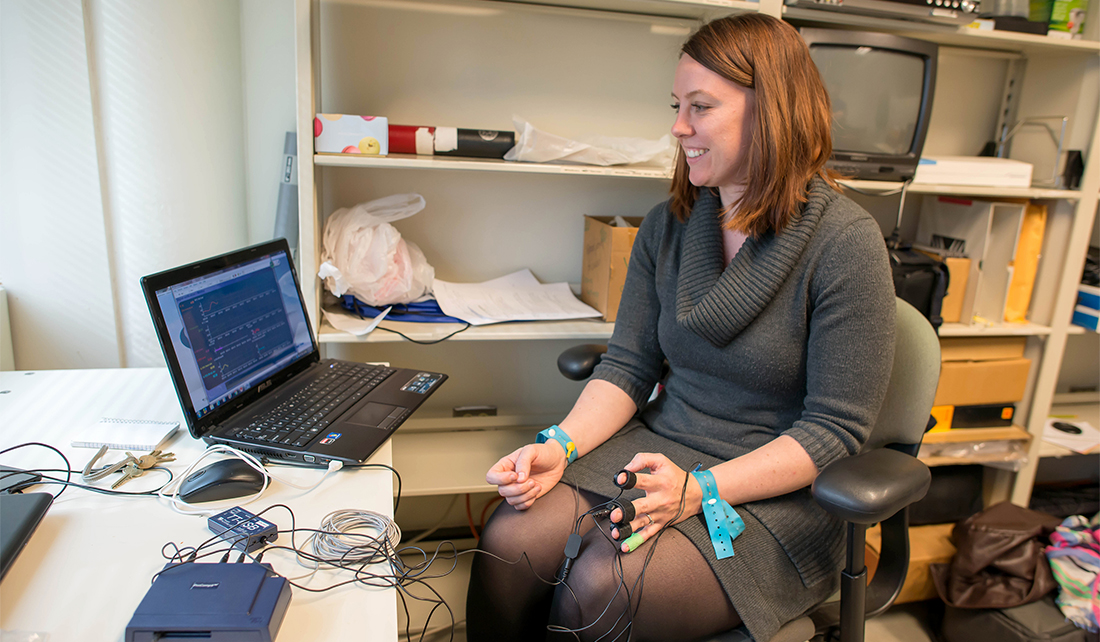
At the same time, Dr. Chun-Yen Chang’s team in Taiwan will use functional magnetic resonance imaging—better known as fMRI—to monitor and map changes in brain blood flow when participants are shown rain garden photos after being put through a series of tests designed to cause mental fatigue.
The researchers only began testing participants this spring, but they have a few predictions about the final results.
“It’s possible that seeing rain gardens in an urban space will help people recover from mental fatigue faster,” said Tum. “On the other hand, rain gardens with a lot of messy plants may make people feel uncomfortable, which may lead to them feeling more stress or mentally fatigue.”
December 3rd, 2015 by iisg_superadmin
 Residents of Illinois, Indiana, and the broader Great Lakes region will benefit from new IISG research. Altogether, the four, two-year projects will receive more than $780,000 starting in 2016.
Residents of Illinois, Indiana, and the broader Great Lakes region will benefit from new IISG research. Altogether, the four, two-year projects will receive more than $780,000 starting in 2016.
John Kelly, a Loyola University biologist, will survey eight major rivers around the lake to trace the origins of microplastics pollution and what river characteristics—such as
surrounding land use or nearby wastewater treatment plants—may be driving this.
Purdue University’s Zhao Ma will lead an interdisciplinary team that seeks to reduce nutrients, sediment, and E. coli contamination in southern Lake Michigan. The team will use models to assess best management practices (BMP) for reducing runoff and the willingness of individuals to implement these BMPs. Looking at these two approaches together will allow them to optimize the best courses of action to reduce overall pollution.
A project led by Sara McMillan, who studies biogeochemistry and hydrology at Purdue University, will examine drainage ditch design from multiple perspectives. McMillan will compare designs that improve long-term stability and ecological effectiveness.
And Beth Hall, Midwestern Regional Climate Center director, will work with Paul Roebber of the University of Wisconsin-Milwaukee to improve how flash flooding events in urban centers are predicted and communicated. Hall and Roebber’s project is partially funded by Wisconsin Sea Grant.
June 23rd, 2015 by iisg_superadmin
It may sound cheesy, but it’s always my dream and goal in life to make a difference in the world and to help others. I always thought this would be something I would have to do outside of my career, however, being an outreach intern for Illinois-Indiana Sea Grant allows me to integrate part of this dream into my career.
This coming fall I will be going into my senior year at the University of Illinois. I am majoring in advertising and minoring in both communication and sociology as well as receiving my certification in public relations. In addition, I am part of the James Scholar Program in the College of Media at U of I.
As an intern, I assist with outreach efforts associated with
R/V Lake Guardian to increase awareness of the
Lake Guardianmission and the research conducted on the ship. My specific duties entail developing a brochure about the ship, assisting with the Lake Guardian Dispatch blog, maintaining and reorganizing the
Lake Guardian website, assisting with daily
social media efforts, and assisting with a kiosk design for the ship. This past week (June 15-18) I was given the opportunity to climb aboard the
Lake Guardian where I was able to develop a full understanding of the vessel along with assist with ongoing sampling, and conduct outreach efforts while on the ship.
Robert Browning once said, “Ah, but a man’s reach should exceed his grasp, or what’s a heaven for?” This past week definitely exceeded my own grasp. My experience on Lake Guardian was a completely new experience for me and I admit that I was a little nervous going into it. After being on board for just a few hours, I was quickly reminded of how rewarding it is to take on a new experience. It truly makes you grow as a person and appreciate new things in life. A typical day for me consisted of photography and videography, live-tweeting, late night blog posting, and assisting with ongoing sampling throughout the day. The work days were long, but seemed to go by quickly. So did my time on the ship, I enjoyed every minute of it.
Our overall trip mission was to collect water, plankton, and benthic invertebrates for organic chemical analysis. This survey is known as the “Great Lakes Fish and Monitoring Surveillance Program: Pushing the Science (Clarkson University)” and assesses how contaminants cycle throughout the food web in Lake Michigan. The vessel consisted of a team of crew members (marine technicians, seamen, engineers, the captain and mates) as well as members from Clarkson University, SUNY Fredonia, SUNY Oswego, NOAA, U.S. EPA GLNPO, and IISG.
The trip was most definitely the experience of a lifetime. I am extremely grateful to have been given the opportunity to experience the Lake Guardian hands-on and to help keep the Great Lakes clean for all through this internship.
March 24th, 2015 by iisg_superadmin
Scientists at the University of Illinois at Chicago have unearthed a species of Lake Michigan bacteria that may become a powerful weapon in the fight against tuberculosis. Found in the sediment off the coast of Milwaukee, the microbe’s medicinal power lies in the small compounds it makes to defend itself.
UIC researcher Brian Murphy and colleagues at the College of Pharmacy are still trying to pin down how the molecules attack the M. tuberculosis bacterium, but they know that the compounds display drug-like potency against a range of antimicrobial-resistant strains that rivals existing clinical treatments.
This study is part of a larger effort by Murphy and others to determine the disease-fighting potential of aquatic actinomycete bacteria. Current treatments for many diseases are built around the chemical defenses used by land-based bacteria, but a growing number of pathogens are now resistant to standard drugs. Results like these in Lake Michigan suggest that freshwater bacteria may create molecules that dangerous pathogens have yet to evolve defenses against, making the Great Lakes a potentially untapped reservoir of treatments for some of the world’s deadliest diseases.
To understand the potential of the lakes, Murphy has collected more than 600 strains of freshwater actinomycete bacteria with support from an IISG Discovery Grant. The size and diversity of the library will help reveal both whether these bacteria are significantly different than their land-based cousins and if strains found in different lakes produce unique chemical defenses.
This analysis is still underway, but Murphy and his team have already discovered that the makeup of actinomycete communities in Lake Huron varies both by location and depth, a diversity that makes the lake a potentially important site in the hunt for new cures.
March 19th, 2015 by iisg_superadmin
Allison Neubauer and Kirsten Walker were at the University of Illinois Public Engagement Symposium last week to raise awareness of IISG outreach in Champaign-Urbana. Allison had this to say about the event.
The public engagement symposium was a great opportunity to find out what other local organizations and academic programs are working on. The crowds of people—both those staffing booths and walking through and exploring—were a true testament to Champaign-Urbana’s widespread effort to get involved and take collective action on local initiatives.
Our IISG table generated a lot of traffic. With spring on the horizon, many visitors were excited to learn about our mobile walking tour of downtown Chicago. Others stopped to discuss invasive species and ways they can help halt their spread.
 But the biggest draw was our university Learning in Community (LINC) course poster, created by undergraduate students enrolled in our section last fall. These students focused on increasing awareness on campus about how pharmaceuticals contaminate our waterways. They also coordinated a take-back event for students and community members to properly dispose of their unwanted medication. The event was a big success, collecting 15 pounds of unused medicine for incineration in just six hours.
But the biggest draw was our university Learning in Community (LINC) course poster, created by undergraduate students enrolled in our section last fall. These students focused on increasing awareness on campus about how pharmaceuticals contaminate our waterways. They also coordinated a take-back event for students and community members to properly dispose of their unwanted medication. The event was a big success, collecting 15 pounds of unused medicine for incineration in just six hours.
For Kirsten and I, what was particularly exciting and unique about this symposium was our ability to connect with others working locally on related problems. For example, a Champaign community health center invited us to discuss pharmaceutical disposal with their patients. There was also a UIUC engineering student interested in the homemade filtration system our LINC students created with local high schoolers to show how some contaminants can slip through wastewater treatment processes. She is currently working to design and implement a water system and health program in a rural Honduran community and was looking for ways to engage with local residents.
December 15th, 2014 by iisg_superadmin
University of Illinois students and faculty took a break from the end-of-semester chaos earlier this month to take advantage of a single-day medicine take-back. The student-led event was part of the Learning in Community (LINC) service course facilitated by IISG.
“We spoke to so many different people to put on this event, from police officers to student organization leaders on campus to Jimmy John’s representatives,” said Reema Abi-Akar, a senior in urban planning. “We looked into case studies of past medicine take-back events, learned the ropes, and slowly absorbed all of the components we needed to replicate to put on a successful event.”
“Preparations for the event were challenging,” added Rosalee Celis, project manager and senior in biomedical engineering. “There were various marketing aspects that still had to be completed and communication between a 10-member team over Thanksgiving break was difficult. However, the efforts exerted during this crunch time made the results more satisfying.”
The event was a success, collecting 15 pounds of unused medicine for incineration in just six hours.
 This was just one of the outreach projects led by the LINC students this year. The class, which includes eight students and two undergraduate project managers, also gave an interactive presentation to an ESL class at Urbana High School to raise awareness of the risks of pharmaceutical pollution and the importance of proper disposal.
This was just one of the outreach projects led by the LINC students this year. The class, which includes eight students and two undergraduate project managers, also gave an interactive presentation to an ESL class at Urbana High School to raise awareness of the risks of pharmaceutical pollution and the importance of proper disposal.
“Our group truly feels like we made a difference in the community and spread the word about proper medicine disposal,” Reema said.
And the course has been an eye-opening experience for the students as well.
“To be honest, I started this experience with little to no knowledge about proper medicine disposal,” Reema continued. “All the old medications in my parents’ medicine cabinet were simply collecting dust for years because we never knew how to get rid of them. Once I came into this LINC class and my group began researching the subject further, I became more and more interested in it—and I believe I’m speaking for my entire group as well.
“I can now enter the professional workforce in the pharmaceutical industry with the awareness of potential environmental damage due to pharmaceutical waste,” said Rosalee.
November 20th, 2014 by iisg_superadmin
Eliana Brown recently joined the Illinois Water Resources Center as an outreach specialist. Prior to starting at IWRC, she worked at University of Illinois at Urbana-Champaign Facilities & Services as the MS4 coordinator and at Illinois EPA as a field engineer. Eliana has a M.S. in environmental engineering and a B.S. in general engineering and marketing from the University of Illinois.
The following is a contributing post from Eliana, who has a passion for rain gardens and green infrastructure:
When you were a university student, did you ever reimagine your campus landscape? Students at the University of Illinois did exactly that as an assignment for Landscape Architecture (LA) 452, Native Plants and Design.
The U of I campus has 84 miles of storm sewer, most of which drain rainwater directly to Boneyard Creek. The LA 452 students designed landscapes with elements that capture water and allow it to soak in on-site to reduce loads to the existing storm sewer and creek. These elements (called green infrastructure) include rain gardens, swales, and green roofs. The Environmental Protection Agency (EPA) sees green infrastructure as a way to create sustainable, resilient communities that improve water quality.
EPA has a competition called the Campus RainWorks Challenge that invites “student teams to design an innovative green infrastructure project for their campus showing how managing stormwater at its source can benefit the campus community and the environment.”
According to Jason Berner, EPA environmental protection specialist, who has been involved with administering the competition, it is a great way for students to see how green infrastructure is related to the larger campus master plan. “It moves us beyond single pilot projects, but at the same time, blends both small and large scale thinking,” he explained.
LA 452 instructor Tawab Hlimi is leading the U of I Campus RainWorks entry. Students in his class helped brainstorm ideas for the entry. One of those ideas is pictured. Student Jiwon
Kim reimagined the grounds at the National Soybean Research Building (which happens to house Illinois-Indiana Sea Grant and the Illinois Water Resources Center). Native plant rain gardens intercept stormwater from the building roof and parking lot. During large storms, the design takes advantage of existing storm sewers by overflowing excess water to them.
Like many cities and universities, the U of I began installing storm sewers more than 100 years ago. Storm sewers benefit cities by draining flooded areas. However, they can overload receiving streams and cause unintended damage. Adding green infrastructure elements to the existing infrastructure helps ensure a healthier ecosystem on-site and downstream.
Per Hlimi, “Through a campus wide application of rain gardens, students hybridized native plantings with a superficial stormwater management strategy to meet multiple objectives: accommodating the ‘first flush’ of frequent storm events through detention, infiltration, and biofiltration, reducing the load on existing subsurface infrastructure, improving the water quality entering into the Boneyard Creek, creating habitat for pollinators, and rendering the campus landscape as living laboratory.”
Perhaps one day in the not too distant future, students won’t have to imagine green infrastructure on campus. They’ll see it.

















